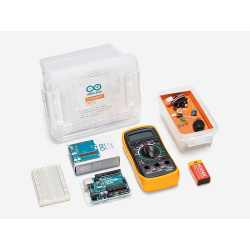Modulino® Distance allows you to sense and measure distance so your projects can interact with the world around them.
The Arduino Modulino® collection includes a variety of plug-and-play smart components that transform complex electronics into simple, interactive projects with minimal code and maximum creativity.
Discover a new generation of ready-to-use sensors and actuators that simplify any build. Designed for makers, educators, and professionals, Modulino® nodes connect effortlessly via Qwiic cables and work together as a unified system thanks to daisy-chain technology.
Start easy, advance quickly
Both beginners and experienced developers can implement sophisticated features thanks to preconfigured Arduino Cloud templates and a dedicated Modulino® library (supporting both Arduino language and MicroPython).
And after the first project is done? Consistent design across all Modulino® nodes gives you the flexibility to swap them and integrate them into a variety of new ideas, while breakout pins allow advanced users to push customization further.
Key benefits
- Plug-and-play connectivity:
Quickly connect Modulino® nodes to Arduino® UNO R4 WiFi or Nano boards, using the Nano Connector Carrier for fast, reliable integration. - Robust, ready-to-use design:
Preassembled, compact modules built to support demanding edge IoT projects. - Effortless expansion:
Easily add new sensors, actuators, or controllers without redesigning your hardware. - Seamless Arduino ecosystem integration:
Leverage Arduino software, Cloud tools, and community support to accelerate development.
Meet all the Modulino® nodes!
In addition to Modulino® Distance, you can explore all the Modulino® nodes in the range!
- Modulino® Knob: for super-fine value adjustments
- Modulino® Pixels: eight LEDs to shine bright, dim down, or change color – you choose!
- Modulino® Movement: to perfectly capture movements like pitch, roll or tilt
- Modulino® Buzzer: to generate your own alarm sounds or simple tunes
- Modulino® Thermo: a sensor for both temperature and humidity data
- Modulino® Buttons: three buttons for quick project navigation
Specifications










